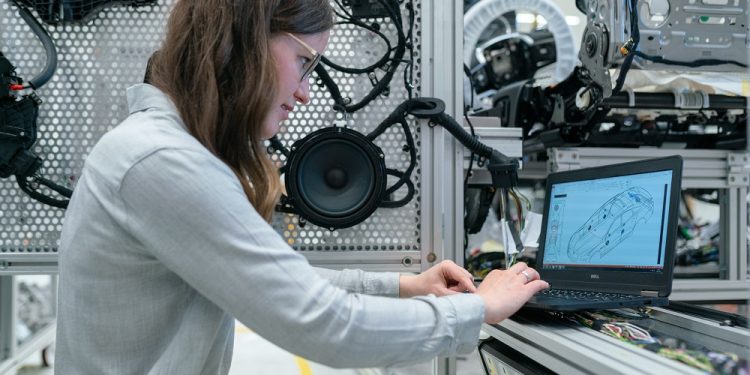Formally, the transition to additive manufacturing began more than 50 years ago, when Johannes F. Gottwald patented the prototype of the first 3D printer in 1971. This liquid metal recorder device could create objects and shape them into desired forms from liquid metal.
However, additive technologies are becoming increasingly popular nowadays, on the threshold of the fourth industrial revolution. According to AMPOWER’s 2023 Additive Manufacturing Report, the global additive manufacturing market has reached €9.5 billion in 2022 and is expected to grow at a CAGR of 17.7% by 2027.
Adopting the right digital tools is critical for additive manufacturing transformation, as software empowers hardware and an entire additive manufacturing process. At Itransition, they believe that custom manufacturing software can be more effective since it’s tailored to the needs and workflows of a particular manufacturer.
This article covers the advantages of custom additive manufacturing software and highlights the most valuable features of these solutions.
Why opt for custom software for additive manufacturing?
Even though there’s plenty of turnkey additive manufacturing software on the market, here are some reasons why you should consider building a custom solution from scratch.
- Aligned with unique business needs
The most prominent benefit of custom manufacturing solutions is that it’s built around the companies’ unique processes and needs. A custom development team can help the manufacturer determine the most relevant functionality and technologies to build into the solution. This way, a company can avoid maintaining unnecessary solutions and save resources.
- Easy adoption among employees
Investments in additive manufacturing software can fail to bring the expected results if a company doesn’t achieve its adoption among employees. In some situations, new software can even decrease worker productivity and thus reduce overall performance. According to the 2022 report from Userlane, 44% of employees postpone tasks due to frustration with new digital tools.
Fortunately, manufacturers can develop highly intuitive and user-friendly solutions to promote user adoption by following user-centered design (UCD) principles. UCD implies collecting and analyzing user feedback starting at the early development stages, allowing engineers to create software that is easy to learn and use.
- Designed for advanced scalability and flexibility
Given that manufacturers define the architecture of custom solutions themselves, they can build scalability into their software already at the ideation and planning stages. For example, a manufacturer can decide to create a set of multiple microservices that are more scalable compared to the traditional monolithic architecture.
The microservices architecture is modular and flexible, which helps manufacturers add new features and technologies to their software quickly. Additionally, given that microservices are typically deployed in the cloud, manufacturers can scale them easily by allocating additional computing resources.
Key additive manufacturing software features
Companies can leverage more business benefits from custom development by enriching their bespoke solutions with the following functionality:
- Advanced 3D design
3D modeling is a key aspect of additive manufacturing, and companies can make it more user-friendly with specialized design tools. The parametric modeling feature is one such tool, as it allows designers to automatically adjust the parameters of entire models by changing one value. Another feature, collaborative 3D modeling, enables designers to collaborate in real time, leaving comments and co-edit models, which increases the speed and quality of work.
- Computer-aided manufacturing (CAM)
With CAD functionality built into it, an additive manufacturing system can analyze 3D data models, automatically calculate the optimal work path and speed for production equipment, and create instructions for 3D printers for building the modeled objects. CAD adoption allows companies to automate production and increase its accuracy to create even more complex parts and products faster.
- Mechanical event simulation
Mechanical event simulation allows companies to speed up the QA process by replacing traditional experiments on a physical prototype with tests on its digital counterpart. With this feature in custom additive manufacturing, engineers and designers can quickly evaluate an object’s stability, strength, and other quality aspects before putting it into production.
- Analytics
3D printers generate vast amounts of data that can be analyzed and used for improving the additive manufacturing process, and this is where built-in analytics features can come in handy. For instance, with the help of analytics, a sourcing department can track material consumption, while maintenance managers can more closely monitor equipment operation.
Final thoughts
The global shift towards additive manufacturing is gaining momentum as more and more companies are switching to additive technologies to create more unique and competitive products, accelerate prototyping, and make production more cost-effective.
Despite all these benefits, the adoption of the right additive manufacturing software can be challenging due to the uniqueness of each company’s needs. Custom development helps overcome this issue through the implementation of additive manufacturing software tailored to manufacturers’ workflows.
Although bespoke development is a rather expensive initiative, companies can optimize its cost by turning to third-party custom developers with experience in the manufacturing industry. Qualified software engineers can implement FinOps and other development best practices into the SDLC to help companies optimize technology spending and accelerate software delivery.






